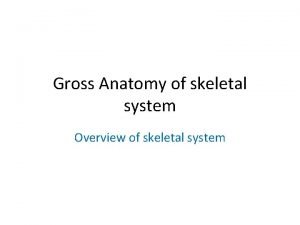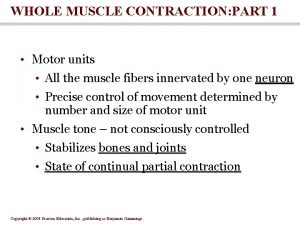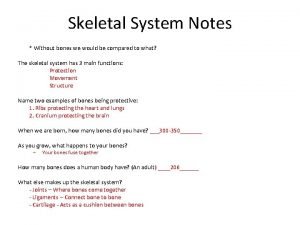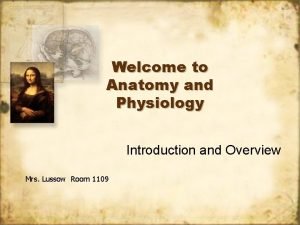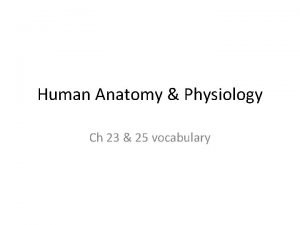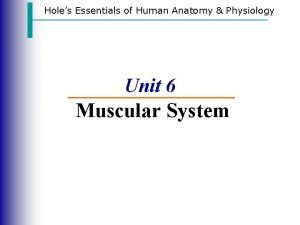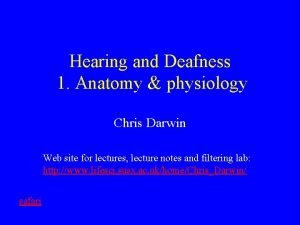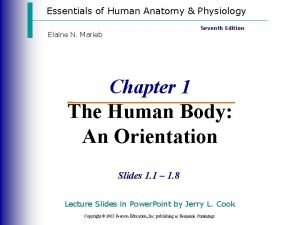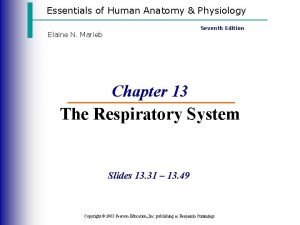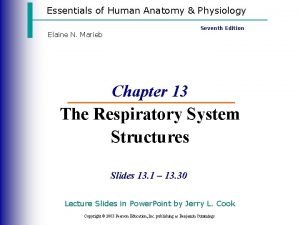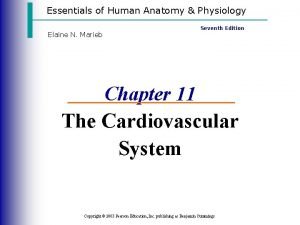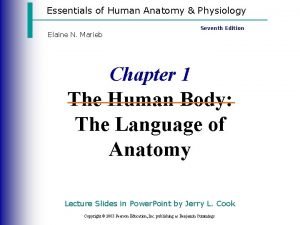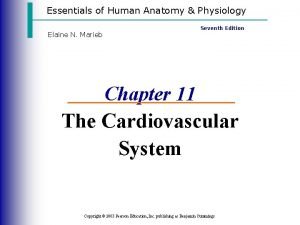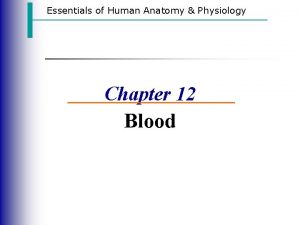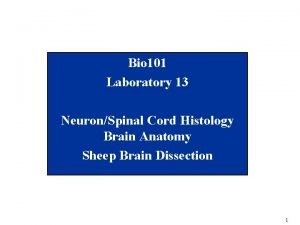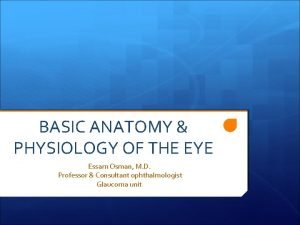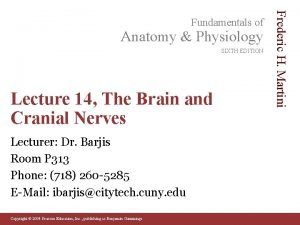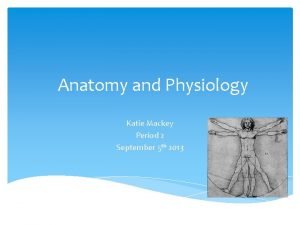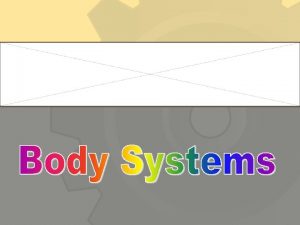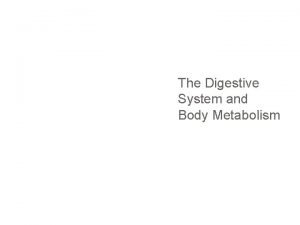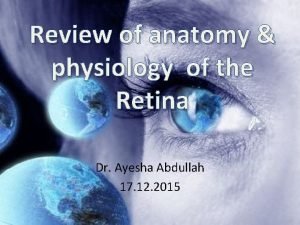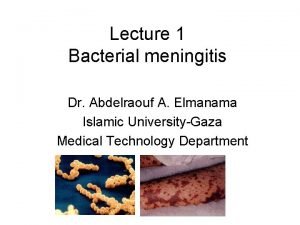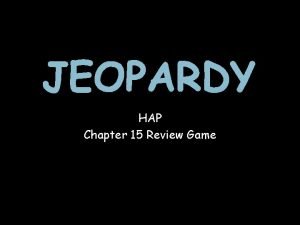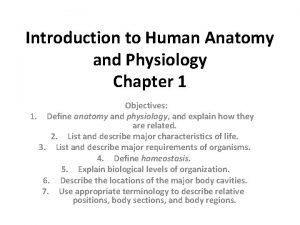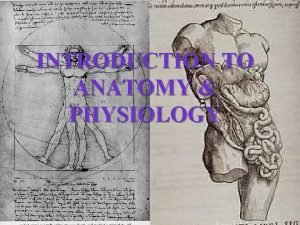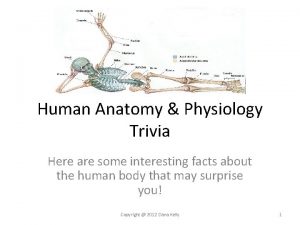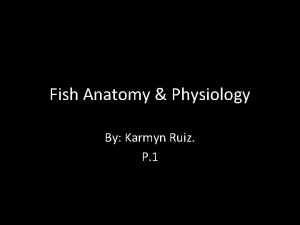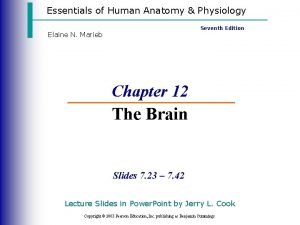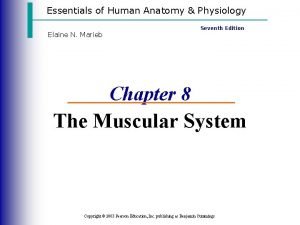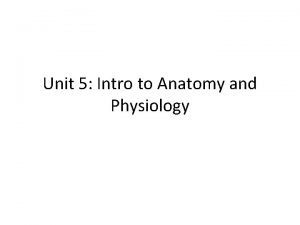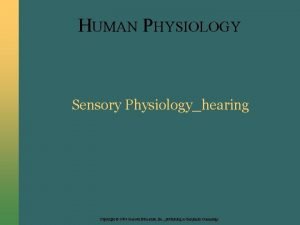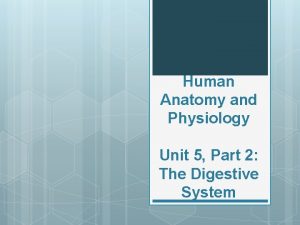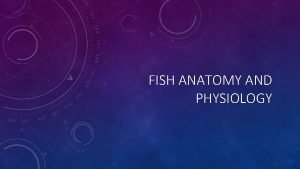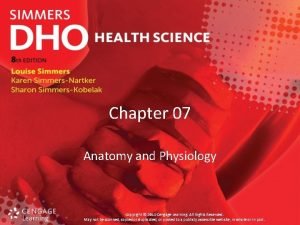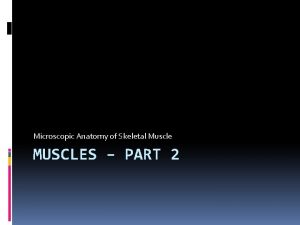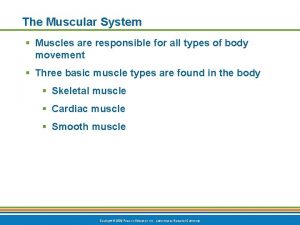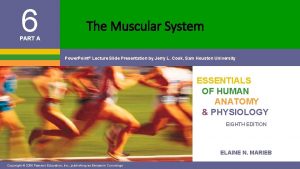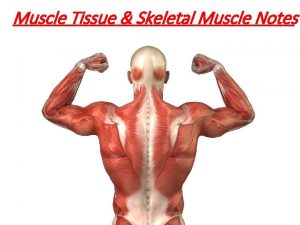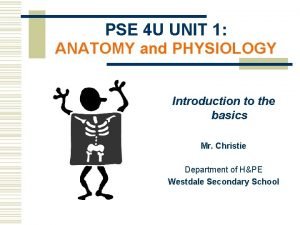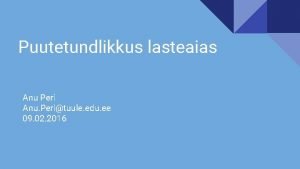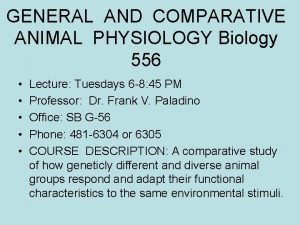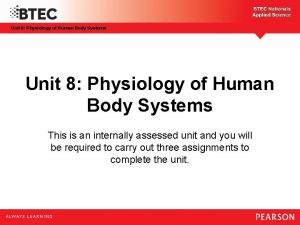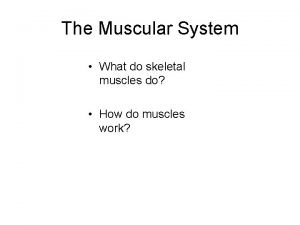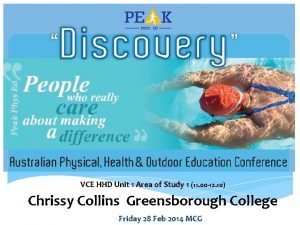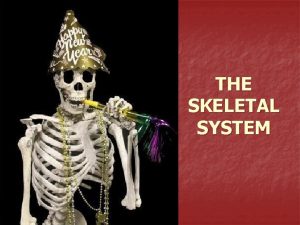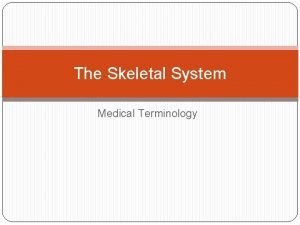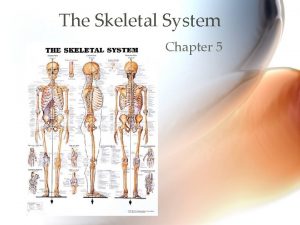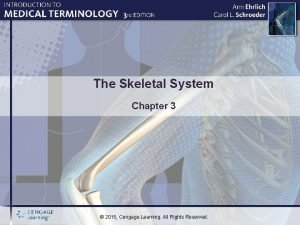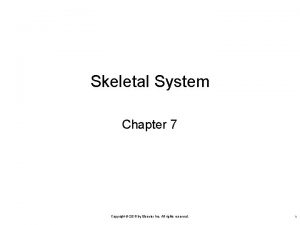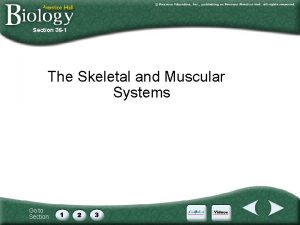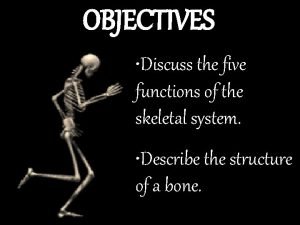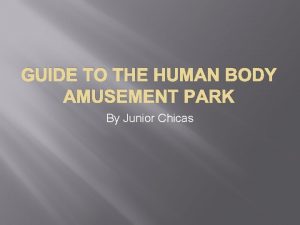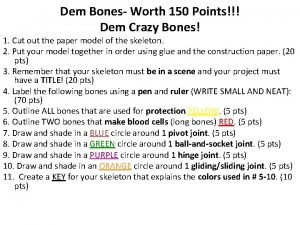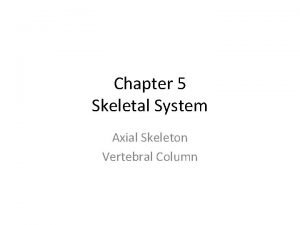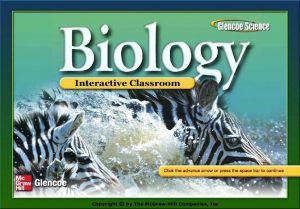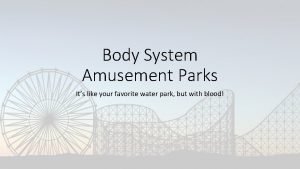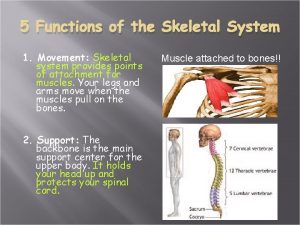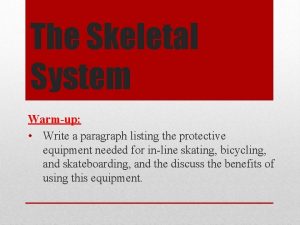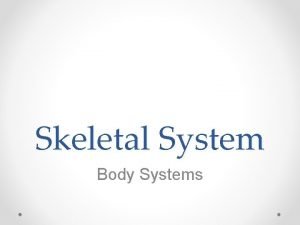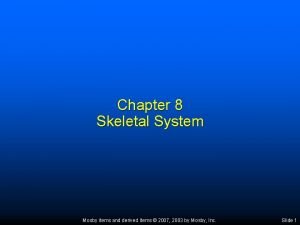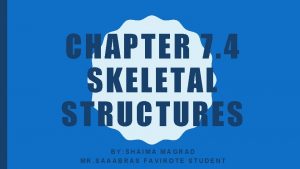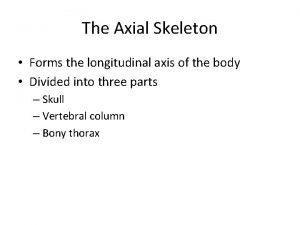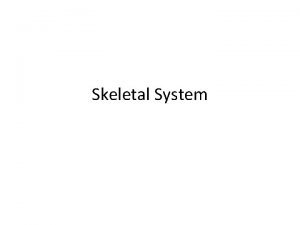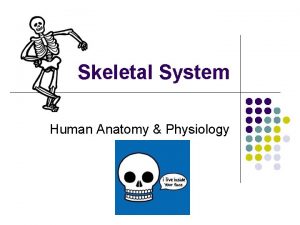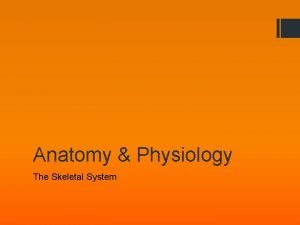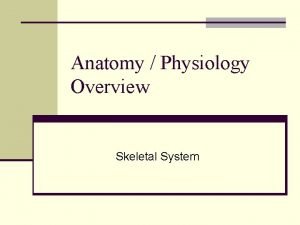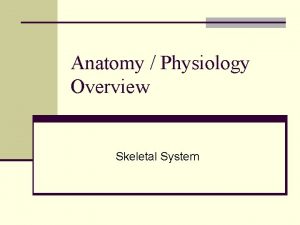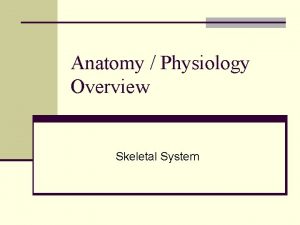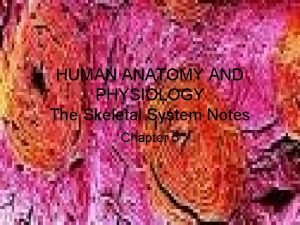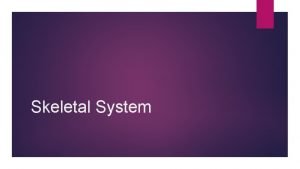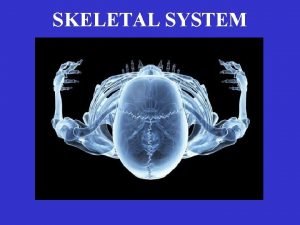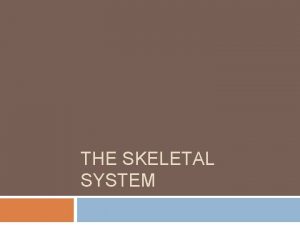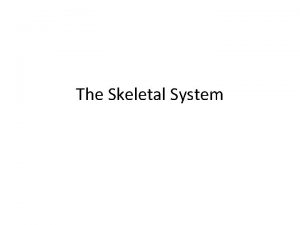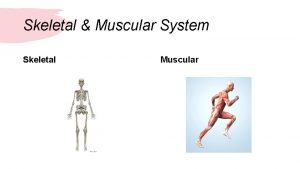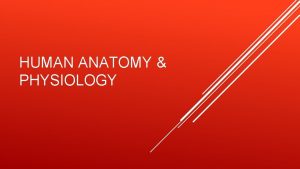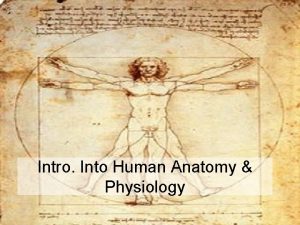HUMAN ANATOMY AND PHYSIOLOGY The Skeletal System Notes



































































































































- Slides: 131

HUMAN ANATOMY AND PHYSIOLOGY The Skeletal System Notes Chapter 5

2 divisions: • ______________bones that form longitudinal axis • ________________bon es of the limbs and girdles Axial skeleton Appendicular skeleton


• The system includes joints , cartilage and ligaments. I. Bones: An Overview • Functions-besides giving body shape and Form: – – 1)Support-supports body and cradles soft organs 2)Protection-protect soft organs-eg. Protects brain/vertebrae-spine and ribs for organs of the thoracic cavity

Functions cont’d • 3)Movement-Skeletal muscles attach to bones by ________and bones work as levers tendons

Functions cont’d Fat – 4)Storage» ______in internal cavities of bones » Storehouse for minerals-esp. Ca and P…. A small amount of Ca must be in blood at all times to reach the nerve tissue for transmission, so muscles contract and help clot blood. Ca in bones as salts go to provide Ca 2+ ions for blood » Hormones control the movement of Ca to and from blood according to body need…. . too much Ca can be a problem 5)Blood Cell Formation or ____________ in the marrow cavities of certain bones hematopoiesis

B. Classification of Bones*(all 206 of them) – • There are 2 main types of osseous tissue » ______________dense and looks smooth and homogeneous ______________ made of needlelike pieces of bone and lots of open space Compact bone Spongy bone


wrist • Many sizes and shapes: -eg. Tiny pisiform bone of _________-size of a pea and at the other extreme-the ________-thigh bone is ~ 2’ long and has large, ball shaped head femur

Shape grouping: – ___________-longer than they are wide; shaft with heads at both ends; mostly compact bone; bones of limbs – _____________-generally cube shaped and mostly spongy bone ; bones of wrist and ankle; __________bones-within tendons-special type of short bone-patella Short bones Long bones sesamoid

Shape cont’d – __________-thin, flattened and usually curved-2 thin layers of compact bone sandwiching spongy boneskull, ribs, sternum – _____________don’t fit other categories-vertebrae and hip Flat bones Irregular bones


C. Structure of a long bone • • • GROSS ANATOMY _________-shaft-makes most of bone length and is _________bone Diaphysis is covered by fibrous connective tissue membrane-_____________-Hundreds of connective tissue fibers, called perforating or Sharpey’s fibers secure periosteum to underlying bone diaphysis compact periosteum

• ________at the ends of each long bone…consists of thin compact layer of bone filled with spongy bone…. _______cartilage covers the external surface(glassy hyaline cartilage gives smoothness to decrease friction at joint surfaces) • Adult bones have a thin line of bony tissue at epiphysis-called __________-a remnant of epiphyseal plate of hyaline cartilage in young , growing bones • epiphyseal plates cause lengthwise growth of bones epiphysis Articular cartilage Epiphyseal line

• At end of puberty, hormones inhibit long bone growth and the epiphyseal plate is completetly replaced w/bone • Cavity of shaft stores adipose tissue-____________, or medullary cavity …In infants this area forms RBC’s-red marrow is there as well • For adults __________is in cavities of spongy bone of flat bones and epiphyses of some long bones—Note: Areas of red marrow are more limited in adults—to places such as sternum • Surfaces have bumps holes and ridges=_____________-show where muscles, tendons, and ligaments were attached and where blood vessels and nerves pass Yellow marrow Red marrow Bone markings

Bone markings – • • 1. projections or processes -grow out from bone surface---goes w/terms beginning w/T 2. depressions or ____________-indentations in bone--goes w/terms starting w/F(except facet cavities




Long Bones-MICROSCOPIC ANATOMY • ___________-mature bones cells found in matrix in lacunae cavities • Lacunae arranged in concentric circles called__________around central(Haversian) canals • _________is a complex of central canal and matrix rings—Haversian system • Central canals run lengthwise through bony matrix to carry blood vessels and nerves to all of bone osteocytes lamellae oteon

Microscopic anatomy cont’d • ___________-tiny canals that radiate outward from central canals to all lacunae-form a transportation system that connects all bone cells to nutrients in matrix --therefore well nourished • _______run into compact bone at right angles to shaft and communicate from outside to interior • Bone light in weight, but strong canaliculi Perforating(Volkmann’s) canals


Bone Formation, Growth and Remodeling • • 2 most strong and supportive tissue-bone and cartilage Except for flat bones, most bones develop using hyaline cartilage as model

Bone formation cont’d • __________-bone formation in 2 phases: – 1)Hyaline cartilage model is completely covered by bone matrix(a “collar”) by bone forming _____________. For a while, fetus has cartilage enclosed by bones. Enclosed hyaline cartilage model is digested away, forming a medullary cavity ossification osteoblasts

– 2)By birth most hyaline converted to bone. except articular cartilage on __________and epiphyseal plates • New cartilage is continually on the face of articular cartilages(covering bone ends) and epiphyseal plate surface that faces bone ends. At the same time, old cartlage abutting internal face of articular cartlage and the medullary cavity is BROKEN down and replaced by bony matrix Bone ends

• Growing bones must widen as they lengthen--osteoblasts in _______add bone tissue to external face of diaphysis as osteoclasts in endosteum remove bone from inner face of diaphysis wall---both occur at same rate circumference of long bone expands and bone widens…. >_________growth. This is controlled by hormones –esp. growth hormones and , during puberty , sex hormones • Overall growth ends at puberty , when ______are converted to bone periosteum Appositional growth Epiphyseal plates


Bones dynamic and active tissue and continuously remodeled in response to : – 1)Ca levels in blood-When blood Ca levels drop below homeostatic levels, the _________in throat stimulated to release parathyroid hormones-______-into blood. PTH activates ______-giant bone destroying cells in bones to break down bone matrix and release Ca into blood. » If blood Ca levels are too high, Ca is deposited into bone matrix as Ca salts Parathyroid glands PTH osteoclasts

• 2. In response to gravity and muscle mass-long bones retain normal proportions and strength and bones become thicker and form large projections to increase their strength where muscle is bulky…. here ________lay down new matrix and become trapped w/in it…. now, trapped, they become osteocytesmature bone cells osteoblasts


• Those that are bedridden and /or weakened lose mass • Rickets-look up p. 142_________________

E. Bone Fractures • Bones amazingly strong • ___________= breaks---in young due to activity level and in older people due to thin and weakened bones_ – 1)Closed fracture-clean break that does not penetrate skin – 2)_________is when the broken bone breaks the skin fractures Opencompound


• A fracture is treated by ________-where the realignment of break happens. In closed breaks, the ends are coaxed back into their position by M. D. . For OPEN breaks, surgery is performed and pins or wires are used. After reduction it is _____________by cast or traction • Simple fracture takes 6 -8 weeks to heal…. bot longer for large bones and bones of older people(due to their poor circulation) reduction immobilized

4 Events for bone repair: – _____________forms and blood cells deprived of nutrition die – The break is splinted by a _________growth of new capillaries(granulation tissue) into hematoma at site of damage. as this happens, connective tissue of various types form a mass called fibrocartilage callus containing some cartilage matrix, some bony matrix, collagen and acts to splint the bone hematoma Fibrocartilage callus

– bony callus forms-more osteoblasts and osteoclasts come to area-the fibrocartilage callus is relaced by one made of spongy bone – Bone remodeling occurs-weeks to monthsforms strong, permanenet bone patch at site


Axial Skeleton Forms longitudinal axis of body

Skull – – Formed by cranium –protects brain and __________-hold eyes in anterior position and allow facial muscles to show expression All but one bone of skull is joined by ______interlocking , immovable joints(mandible has a freely movable joint) Facial bones sutures

Cranium-8 large , flat bones • • • ______________forms forehead, bony projections under eyebrows, and superior portion of orbit ______________paired, forms superior and lateral walls of cranium; include _____________and ______suture Temporal Bones(pair) lie inferior to parietal and join at __________________ Frontal bone Parietal bones Squamous sutures Sagittal suture coronal

Temporal bone markings: • a-External acoustic meatus-leads to eardrum and middle ear-here sound enters ear • b-Styloid process-sharp/attachment for many neck muscles • c-_________-process bridge of bone that joins with cheek bone(zygomatic bone) anteriorly • d-Mastoid process-full of air cavities(mastoid sinuses)-rough projection posterior and inferior to external acoustic meatus-some neck muscles attach here---The proximity to middle ear makes these sinuses a hot spot for infections- _____________---also could spread to the brain Zygomatic process Mastoiditis

• d-_______foramen allows passage of jugular vein(largest vein of head-drains the brain)-anterior to this is the e-__________-transmits cranial nerves VII and VIII-facial and vestibulocochlear nerves…. f- anterior to foramen is carotid canal that carotid artery brings most of the blood to the brain Jugular foramen Internal acoustic meatus

• Occipital bone-most posterior of cranium-floor and back wall of skull • a. _____________suture joins this bone with parietals • b. ___________magnum allows spinal cord to connect to brain • c. ___________________rest on 1 st vertebra Lambdoid suture Foramen magnum Occipital condyles

Sphenoid bone-butterfly shaped-spans width of skull and is some of floor of cranial cavity • ____________”Turk’s saddle”-encloses pituitary gland • Foramen ovale allows cranial nerve v(trigeminal)to pass to chewing muscles of mandible. • Parts form part of eye orbit • Have 2 important openings • 1 -___________allows optic nerve to pass and • 2 -___________through which cranial nerves III, IV, VI pass to control eye movement • Many air cavities--_________________ Sella turcica Optic canal sphenoid sinuses Superior optical fissure

Ethmoid Bone-anterior to sphenoid • _____________”cocks comb”outermost covering of brain attaches here • Small holes on each side of crista galli___________-for olafactory nerves • Extensions form superior and ____________-lateral walls of nasal cavity-and increase turbulence of air here Crista galli Cribiform plates middle nasal conchae

facial bones-14 bones-12 are paired plus mandible and vomer • Maxillae(maxillary)-2 fuse to form upper jaw-main –or keystone bones of the face-carry upper teeth in a)alveolar margin • b)palatine processes-form anterior part of hard palate of _________ • c) ____________sinuses drain into nasal cavity, lighten skull bones and amplify sound we make…. mucosa continue into nose and throat and is a source of _____________infection of sinuses which is an infection of sinuses mouth Paranasal sinuses sinusitis

• ___________pairedposterior part of hard plate-failure to fuse medially is called _________________ _ Cleft palate Palatine bones


Zygomatic bones • _________________ cheekbones-also border of eye sockets • Lacrimal bones-finger-sized bones-part of medial wall of each orbit-each has a groove for tears

Nasal bones • ____________-small rectangular making bridge of nose—lower part is cartilage • Vomer bone-single bone in median of nasal cavitymost of nasal septum • Inferior nasal conchae-thin, curved-lateral walls of nasal cavity • ___________-lower jaw-largest and strongest bone of face…. meets temporal bone and is only freely movable joint of face • ---lower teeth lie in ___________ mandible Alveolar margin

• 3. Hyoid Bone-not really skull, but closely related to mandible and temporal bones-movable base for tongue and attachment for neck muscles

• *****Fetal Skull—face small compared to cranium, but skull large compared to infant’s body(1/8 of body length in adult and _____body length in infant 1/4

fontanels • fibrous membranes connecting cranial bones-“soft spots’-allow compression during birth and allows for brain growth in late pregnancy and early infancy--fontanels replaced by bone by 22 -24 mos. after birth







B. Vertebral Column-Spine – – – Axial support of body-goes from skull(support) to pelviswhere it transmits weight 26 irregular bones connected and reinforced by ligaments -resulting in flexible, curved structure Surrounds and protects spinal cord Before birth is 33 vertebrae-9 fuse to form _________ and _____________ There are 7 in neck_______________; 12_____________; and 5 in lower back-lumbar sacrum coccyx Cervical vertebrae Thoracic vertebrae

– Individual vertebrae separated by flexible pads of fibrocartilage-_______-allow flexibility and absorb shocks – Intervertebral discs 90 % water in youth and are spongy and compressible---water amount decreases w/ age and less compressible – _____disks is a slipped disc-occurs w/age and/or great twisting force • The discs and the “S” shape to spine function to prevent shock to head Intervertebral discs herniated

– The curvature in thoracic and sacral regions are called _________________because they are present at birth---a”C” in a newborn – The curvature in cervical and lumbar regions are called ____________________ because they develop when the baby is ready to walk Primary curvatures secondary

ABNORMAL SPINAL CURVATURES: • ____________, lordosis and _________-may be congenital or from diseases…. scoliosis kyphosis


COMMON FEATURES OF VERTEBRAE – Body or __________disclike, weight-bearingfacing anteriorly – ______________arch formed from joining of all posterior extensions_________________ – _______________-canal through which spinal cord passes centrum Vertebral foramen Vertebral arch Laminae and pedicles

– Transverse processes-2 lateral projections from the arch – _______________-single projection from post. Aspect of arch(= fused laminae – ___________________-paired projections Lateral to vertebral foramenallows a vertebra to form joints w/ adjacent vertebrae Spinous processes Superior and inferior articular processes


Vertebral Regions – – – axis C 1 and c 2 7 1 st 2 atlas and______. Atlas has no body; Transverse processes contain lg depressionsto receive occipital condyles of skull— allows nodding (“yes”)/Axis is a pivot for rotatopn of atlas and skull ______pivot point on axis Joint between______allow you to rotate head from side to side(“no) C 3 through C 7 lightest and smallest vertebrae; usually spinosous process short and in 2 branches-___________contain foramina(for vertebral arteries) dens Transverse processes

THORACIC • • • 12(T 1 -T 12)-all typical Only vertebrae to articulate with ribs Body somewhat heart –shaped and has 2 costal facets(articulating surfaces 0 on ea. Side receiving heads of robs Transverse processes articulate w/knoblike tubercles of ribs Spinosous process long

Lumbar(L 1 -L 5) » » Massive blocklike bodies; short spinous processes (“moose head”) Sturdiest vertebrae because receives most stress

Median sacral crest SACRUM alae • From fusion of 5 vertebrae • Superiorly articulates w/L 5 and inferiorly connects w/coccyx • Winglike _____articulaterally w/hip bone, making sacroiliac joints • Posterior wall of pelvis • ______fused spinous process of sacral vertebrae • Laterally-_______ • Sacral canal terminates in ________opening Posterior sacral foramina Sacral hiatus


COCCYX: • Fusion of 3 -5 tiny vertebrae • Tailbone




C. THORACIC CAGE • Sternum, ribs and thoracic vertebrae=_______________, also called thoracic cage • Sternum(breastbone) • Flat and is the fusion of 3 bones: ____________________ • Attaches to the 1 st 7 prs. of ribs Bony thorax Manubrium, body, xiphoi d process

Bony landmarks: – _______________concave upper border of manubrium-level of T 3 – _______________from manubrium body meeting at slight angle to each other, making transverse ridge-level of 2 nd rib – ________________-pt. where sternal body and xiphoid process fuse-level of 9 th vertebrae Jugular notch Sternal angle Xiphesternal joint

• _______________taking marrow sample at sternum for diagnoses of blood diseases Sternal puncture

Ribs-12 pairs • All articulate with vertebral column and then curve downward • ____________-1 st 7 pairs attch directly to sternum by _________________ • _____________-next 5 pairs either not attached to sternum or indirectly. Last 2 pair are called _______________sometimes • Intercostals spaces attach to intercostals muscles True ribs Costal cartilages False ribs Floating ribs



• • III. Appendicular Skeleton 126 bones of limbs and pectoral or pelvic girdle(which attach limbs to axial skeleton)

A. Bones of Shoulder Girdle

Clavicle scapula collarbone – 2 bones: ____and _____ » 1. CLAVICLE » Also called ___________ » Slender , doubly curved and attaches to manubrium and to scapula(shoulder joint » Brace against arm touching top of thorax and helps prevent________ » w/o it shoulder caves in Shoulder dislocation

2. SCAPULAE • • • -shoulder blades-triangular and commonly called __________because they flare when we move our arms posteriorly Each has a flattened body with _________process-enlarged spine of scapula-connects clavicle at acromialclavicular joint and beaklike ___________________ That points over top of shoulder and anchors some arm muscles wings Acromian coracoid

Suprascapular notch • ______________-serves as nerve passageway • Scapula loosely held by trunk muscles • Scapula has 3 borders-_____________ and 3 angles: superior, inferior and lateral • __________-shallow socket receives head of arm bone-in lateral angle Superior, medial(vere -bral) and lateral(axiallary) Glenoid cavity

Shoulder girdle is light and allows upper limb free movement due to 3 factors: – each shoulder girdle attaches at one point to axial skeleton-________________ – loose attachment of scapula allows it to slide back and forth v. thorax – ______________is shallow and shoulder joint is poorly reinforced by ligaments • *****drawback to so much flexibility is _________ dislocation Sternoclavicular joint Glenoid cavity


B. Bones of the Upper Limbs-30 bones-arms, forearms and hands • ARM • Humerus-head fits into glenoid cavity, _____________; 2 bony projections separated by intertubercular sulcus and ___________-sites of muscle attachment; also ______________most frequently fractured part of bone; ______________roughened area in mid-shaft-deltoid muscle attaches Greater and lesser tubercles Anatomical neck Surgical neck Deltoid tuberosity

Radial groove Medial trochlea • ______________runs down posterior aspect of shaft, marking the place for the radial nerve; distal is the ________-spool-like; ballike capitulum; coronoid and olecranon fossaedepressions that articulate w and medial and ___________allow ulna to move freely when elbow is bent and extended Lateral epicondyles


• • 2. -forearm – ________-lateral bone on thumb side Both bones of forearm articulate at radioulnar joints 2 bones connected by _______________ Both have ____________at distal end __________-below head-tendon of biceps muscle attaches ____________medial bone on little finger side Proximal end has __________ and olecranon process, separated by trochlear notch-grip trochlea of humerous Interosseus membrane radius Styloid process ulna Radial tuberosity coronoid


2. hand-carpals, metacarpals and phalanges – – – carpal 8 _______bones-2 irregular rows of 4 bones ea. -form carpus(wrist)-bound by ligaments to restrict movement between them(see 8 names p. 1620) Palm consists of _______________-#’ed 15(thumb side outward); heads are knuckles Ea. hand has 14 phalanges(3 ea. Finger-thumb has 2) metacarpals


Ossa coxae Axial skeleton C. bones of the Pelvic Girdle- • formed by 2 coxal(___________)-hip bones; form bony pelvis w/sacrum and coccyx • bony pelvis=2 coxal bones, sacrum and coccyx; whereas pelvic girdle=2 coxal bones • large and heavy and attached securely to ______________ • sockets deep and securely attached by ligaments • most important function is ______________ and protect organs • each hip bone formed by fusion of 3 bones: __________ Bearing weight Ilium, ischium and pubis

• ilium -connects posteriorly w/ __________joint-forms most of hip bone; alae are winglike portions of ilia-upper portion= ___________ and ends at anterior superior iliac spine and posteriorly w/posterior iliac spine Sacroiliac joint Iliac crest

Sit-down bone Ischial tuberosity • ischium-____________-inferior of coxal bone; _____________roughened area receiving weight when sitting; ischial spine-superior to tuberosity-THIS NARROWS THE OUTLET OF PELVIS FOR PASSAGE OF BABY IN CHILDBIRTH ! • ----______________allows blood vessels and lg sciatic nerve to pass from pelvis posteriorly into thigh---injections must stay clear of this area Greater sciatic notch

• ____________most anterior of coxal; _________________opening that allows blood vessels and nerves to pass to ant. Thigh; each pubis joins to form cartilaginous joint_________________ • Ilium, ischium and pubis fuse at deep socket: _________________“vinegar cup”-receives head of thigh bone pubis Obturator foramen Pubic symphysis acetabulum

• Bony pelvis divided into false and true pelvis-which must large enough to allow passage of infants head in women for childbirth____________measured by obgyn Dimensions of cavity

• Individual pelvic measurements vary, but stark difference in male and female – Female inlet larger and more circular – Fem. pelvis as a whole more shallow and bones lighter and thinner – Fem ilia flare more laterally – Her sacrum shorter and less curved – Her ischial spines shorter and farther apartthus outlet larger

Her pubic arch rounder because angle of pubic arch greater


D. Bones of Lower limbs-carry total body weight when erect-thus very thick and stronger

Thigh-=________-heaviest and strongest bone of body femur • Proximal has ball-like head, neck and _____________-separated anteriorly by intertrochanteric line and posteriorly by intertrochanteric crest-----along w/ gluteal tuberosity form sites for muscle attachment; head articulates w/ acetabulum-but also a big fracture site-esp. in elderly; slants medially to bring in line w/center of gravity; lateral and medial condyles distally-articulate w/tibia below……these condyles separated by deep intercondylar fossa/anterior is smooth ___________-forms joint w/patella-knee Greater and lesser trochanters Patellar surface


Leg Interosseus membrane knee » -tibia and fibula connected by ____________-tibia is shin bonecondyles proximally and articulate w/distal femur to make ____joint-patellar ligament attaches to ___________distally___________forms inner bulge of ankle-ant. tibia is sharp-anterior border for muscles » ________-lies alongside tibia and joints proximally and distally-NO PART Of KNEE JOINT -lateral malleolus outer part of ankle Tibial tuberosity Medial malleolus fibula

Support weight and act as lever talus FOOT » » » calcaneus Tarsals, metatarsals and phalanges 2 most important functions_____ Tarsus-post. 1/2 of foot-7 tarsal bones ________-heelbone _______lies between tibia and calcaneus » 5 metatarsals and 14 phalanges-each toe has 3 phalanges and big toe has 2 » Form 3 strong arches-bound by ligaments and tendons(for muscles)fallen arches or flat feet occur



• IV. Joints= articulations • *****Except for hyoid, all bones form joints with at least 1 other bone

• 2 functions: __________ and give rigid skeleton mobility • 2 classifications; 1)functionally-focuses on movement. There are • ****_________immovable and ___________slightly movable(1 st 2 in axial skeleton) and ______freely movable(limbs) • 2)structurally-based on whether fibrous tissue, cartilage or joint cavity separate bony regions-fibrous, cartlagenous and synovial Hold bones together diarthroses synathroses amphiarthroses

A. Fibrous Joints-united by fibrous tissue-ex. Sutures of skull-bound by connective tissue fibers w/no movement ____________-connective fibers longer than sutures-so has more “give syndemoses

• B. Catilagenous Joints-connected by cartilageslightly movable-ex; pubic symphysis of pelvis and ____________-pads of fibrocartilage— also epiphyseal plates and synarthrotic-immovablejoints of 1 st ribs and sternum Intervertebral joints

Synovial Joints-joint cavity contains synovial fluid • 4 features: • __________-hylaline-covers end of joint bones • _________-joint surfaces enclosed by sleeve of fibrous connective tissue and capsule lined w. /synovial membrane • Joint cavity-articular capsule encloses a cavitywcontaing lubricating fluid • ______-fibrous capsule reinforced w/ligaments Articular cartilage Fibrous articular capsule Reinforcing ligaments

bursae Tendon sheath – ________flattened fibrous sacs w/ thin film of synnovial fluid-common where ligaments, muscles, skin, tendons or bones agitate – _____________elongated bursa that wraps completely around a tendon – _____________-bone forced out of normal position dislocation



• Types of synovial joints based on Shape: – __________-articular surface flatshort slipping and gliding-nonaxial—intercarpal wrist joints – _______-cylindrical end of one bone fits into trough-shaped surface of another-angular movement in 1 plane----elbow, ankle and fingersuniaxial-1 axis – ____-rounded end of one bone fits into sleeve or ring of another of bone and maybe ligaments-uniaxial—examples: proximal radioulnar joint and joint between atlas and ________of axis Plane joint Hinge joint Pivot joint dens

– ______________”knuckle-like”— egg-shaped surface into oval cavity-side to side or back and forth-can’t rotate around long axisbiaxial-knuckle joints – Saddle joints-convex and concave area on both surfaces-thumb-twiddling thumbs – ______________head of one bone in round socket of another-multiaxial-shoulder and hips Condyloid joint Ball-andsocket joint



bursitis sprain • _____________-inflammation of bursae or synovial membrane • ____________-ligaments or tendons damaged by stretching-or torn-heal slowly due to poor blood supply

• _________> 100 different inflammatory or dgenerative joint diseases---possibly bacterial invasion • _______(OA)-most common arthritis-chronic and degenerative , typically afftects aged-affects articular cartilage-bone thickens and bone spurs grow on margin of joint-make crunching______-noise----affects fingers, C and L spine and knees and hips; slow and irreversible, but rarely crippling; can be treated symptomatically for pain and inflammation…. possible treatments(? )-capsaicin or glucosamine sulfate arthritis osteoarthritis crepitus

• ______________(RA)-a chronic inflammatory disorder-usually begins 40 -50, but there is a juvenile form; 3 x as many women as men-many joints affected and usually symmetrically; course varies. It is _____________-destroy own tissue-trigger unknown; begins w/ inflammation of synovial membranes and fluid accumulates and destroy tissue; PANNUS-abnormal tissue clings to joint and erodes articular cartilage; scar tissue forms and ossifies and bone ends become firmly fused________________-not all cases reach this stage. Treatment includes immunosuppressant drugs and symptomatic treatment Rhematoid arthritis autoimmune ankylosis


gout • ____________-uric acid(normal waste of nucleic acid metabolism) accumulates in blood and may deposit as crystals in joints-extreme pain…. more common in men, usually after 30 untreated bones fuse and joint is immobilized…. several drugs prevent acute goutcolchicine, ibuprofen and dietary recommendations

V. Developmental aspects • Young fetus is _____________ and fibrous membranes • Bone growth along epiphyseal plates as one matures • Changes from”C” spine to “S” spine • _____________-bone thinning disease - Hyaline cartilage osteoporosis

• READ THIS SECTION AND TAKE ADDITIONAL NOTES

 Appendicular skeleton pectoral girdle
Appendicular skeleton pectoral girdle Cornell notes for anatomy and physiology
Cornell notes for anatomy and physiology 3 layers of muscle
3 layers of muscle Chapter 1 introduction to human anatomy and physiology
Chapter 1 introduction to human anatomy and physiology Holes essential of human anatomy and physiology
Holes essential of human anatomy and physiology Chapter 1 introduction to anatomy and physiology
Chapter 1 introduction to anatomy and physiology Chapter 2 human reproductive anatomy and physiology
Chapter 2 human reproductive anatomy and physiology Paratubular cyst
Paratubular cyst Anatomy and physiology edition 9
Anatomy and physiology edition 9 Anatomy and physiology unit 7 cardiovascular system
Anatomy and physiology unit 7 cardiovascular system Respiratory system of human
Respiratory system of human Sally left the party to take cathy home
Sally left the party to take cathy home Physiology of muscle contraction
Physiology of muscle contraction Without bones we would be
Without bones we would be Pulmonary ventilation
Pulmonary ventilation Tattoo anatomy and physiology
Tattoo anatomy and physiology Anatomy science olympiad
Anatomy science olympiad Imperfect flowers examples
Imperfect flowers examples Anatomy and physiology bone
Anatomy and physiology bone Anatomy of ulcer
Anatomy of ulcer Sheep liver lobes
Sheep liver lobes Difference between anatomy and physiology
Difference between anatomy and physiology Difference between anatomy and physiology
Difference between anatomy and physiology Rbc anatomy and physiology
Rbc anatomy and physiology The central sulcus divides which two lobes? (figure 14-13)
The central sulcus divides which two lobes? (figure 14-13) Http://anatomy and physiology
Http://anatomy and physiology Physiology of appendicitis
Physiology of appendicitis Aohs foundations of anatomy and physiology 1
Aohs foundations of anatomy and physiology 1 Aohs foundations of anatomy and physiology 2
Aohs foundations of anatomy and physiology 2 Anatomical planes
Anatomical planes Anatomy and physiology chapter 8 special senses
Anatomy and physiology chapter 8 special senses Chapter 13 anatomy and physiology of pregnancy
Chapter 13 anatomy and physiology of pregnancy Unit 26 animal anatomy physiology and nutrition
Unit 26 animal anatomy physiology and nutrition Science olympiad forensics cheat sheet
Science olympiad forensics cheat sheet Anatomy and physiology chapter 2
Anatomy and physiology chapter 2 Stomach anatomy and physiology ppt
Stomach anatomy and physiology ppt Anatomy and physiology of diabetes
Anatomy and physiology of diabetes Chapter 7:9 lymphatic system
Chapter 7:9 lymphatic system Anatomy and physiology coloring workbook chapter 14
Anatomy and physiology coloring workbook chapter 14 Chapter 10 blood anatomy and physiology
Chapter 10 blood anatomy and physiology Aohs foundations of anatomy and physiology 1
Aohs foundations of anatomy and physiology 1 Aohs foundations of anatomy and physiology 1
Aohs foundations of anatomy and physiology 1 What produces bile
What produces bile Anatomy and physiology chapter 15
Anatomy and physiology chapter 15 Necessary life functions anatomy and physiology
Necessary life functions anatomy and physiology Holes anatomy and physiology chapter 1
Holes anatomy and physiology chapter 1 Gi tract histology
Gi tract histology Anatomy and physiology
Anatomy and physiology Aohs foundations of anatomy and physiology 1
Aohs foundations of anatomy and physiology 1 Aohs foundations of anatomy and physiology 1
Aohs foundations of anatomy and physiology 1 Chapter 1 an introduction to anatomy and physiology
Chapter 1 an introduction to anatomy and physiology Physiology exam 1
Physiology exam 1 Welcome to anatomy and physiology
Welcome to anatomy and physiology Anatomy and physiology of the foot
Anatomy and physiology of the foot Skin cancer
Skin cancer Pancreas anatomy histology
Pancreas anatomy histology Anatomy and physiology vocabulary
Anatomy and physiology vocabulary Anatomy and physiology
Anatomy and physiology Muschiul subclavicular
Muschiul subclavicular Anatomy and physiology
Anatomy and physiology Body landmarks diagram
Body landmarks diagram Anatomy and physiology
Anatomy and physiology Anatomy and physiology
Anatomy and physiology Anatomy and physiology
Anatomy and physiology Anatomy and physiology
Anatomy and physiology Figure 11-8 arteries
Figure 11-8 arteries Anatomy and physiology
Anatomy and physiology Anatomy and physiology
Anatomy and physiology Anatomy and physiology
Anatomy and physiology Anatomy and physiology revealed
Anatomy and physiology revealed Anatomy and physiology of eye
Anatomy and physiology of eye Oblongata
Oblongata Irn.org anatomy and physiology
Irn.org anatomy and physiology Anatomy and physiology body parts
Anatomy and physiology body parts Unit 26 animal anatomy physiology and nutrition
Unit 26 animal anatomy physiology and nutrition Figure 14-1 anatomy and physiology
Figure 14-1 anatomy and physiology Anatomy and physiology of the retina
Anatomy and physiology of the retina Anatomy and physiology
Anatomy and physiology Anatomy and physiology of meningitis ppt
Anatomy and physiology of meningitis ppt Jeopardy anatomy and physiology game
Jeopardy anatomy and physiology game Homeostasis definition
Homeostasis definition Anatomy and physiology
Anatomy and physiology Anatomy and physiology trivia
Anatomy and physiology trivia Cycloid scales
Cycloid scales Anatomy of brain
Anatomy of brain Anatomy and physiology
Anatomy and physiology Body planes and axes
Body planes and axes 2012 pearson education inc anatomy and physiology
2012 pearson education inc anatomy and physiology Layers of esophagus
Layers of esophagus Fish anatomy and physiology
Fish anatomy and physiology Chapter 6 general anatomy and physiology
Chapter 6 general anatomy and physiology Cengage anatomy and physiology
Cengage anatomy and physiology Microbial physiology and metabolism lecture notes
Microbial physiology and metabolism lecture notes Microscopic anatomy of skeletal muscles
Microscopic anatomy of skeletal muscles Microscopic anatomy of skeletal muscle figure 6-2
Microscopic anatomy of skeletal muscle figure 6-2 Microscopic anatomy of skeletal muscle figure 6-2
Microscopic anatomy of skeletal muscle figure 6-2 Microscopic anatomy of skeletal muscle
Microscopic anatomy of skeletal muscle Skeletal muscle
Skeletal muscle Pse4u
Pse4u Skeletal notes
Skeletal notes Comparative animal physiology notes
Comparative animal physiology notes Unit 8: physiology of human body systems
Unit 8: physiology of human body systems Major skeletal muscles
Major skeletal muscles Skeletal and muscular system
Skeletal and muscular system Vce hhd study design
Vce hhd study design Blood supply of lateral wall of nose
Blood supply of lateral wall of nose Five functions of the skeletal system
Five functions of the skeletal system Medical terminology skeletal system
Medical terminology skeletal system Chapter 5 the skeletal system
Chapter 5 the skeletal system Chapter 3 skeletal system answer key
Chapter 3 skeletal system answer key Chapter 7:4 skeletal system label the skeleton
Chapter 7:4 skeletal system label the skeleton Chapter 5 the skeletal system figure 5-13
Chapter 5 the skeletal system figure 5-13 Section 36-1 the skeletal system
Section 36-1 the skeletal system What are the five functions of the skeletal system?
What are the five functions of the skeletal system? Park of body
Park of body The skeletal system dem crazy bones
The skeletal system dem crazy bones Chapter 6 the skeletal system answer key
Chapter 6 the skeletal system answer key 7 12 5 spine
7 12 5 spine Chapter 32 section 2 the skeletal system answer key
Chapter 32 section 2 the skeletal system answer key Digestive system amusement park names
Digestive system amusement park names 5 functions of the skeletal system
5 functions of the skeletal system Regions of the body
Regions of the body Skeletal system paragraph
Skeletal system paragraph Crash course axial skeleton
Crash course axial skeleton Whats the main function of the skeletal system
Whats the main function of the skeletal system Chapter 8 skeletal system
Chapter 8 skeletal system Chapter 7:4 skeletal system
Chapter 7:4 skeletal system Chapter 5 the skeletal system figure 5-10
Chapter 5 the skeletal system figure 5-10 Skeletal system
Skeletal system The axial skeleton forms the longitudinal axis of the body
The axial skeleton forms the longitudinal axis of the body Skeletal system bell ringer
Skeletal system bell ringer Axial skeleton vs appendicular
Axial skeleton vs appendicular











